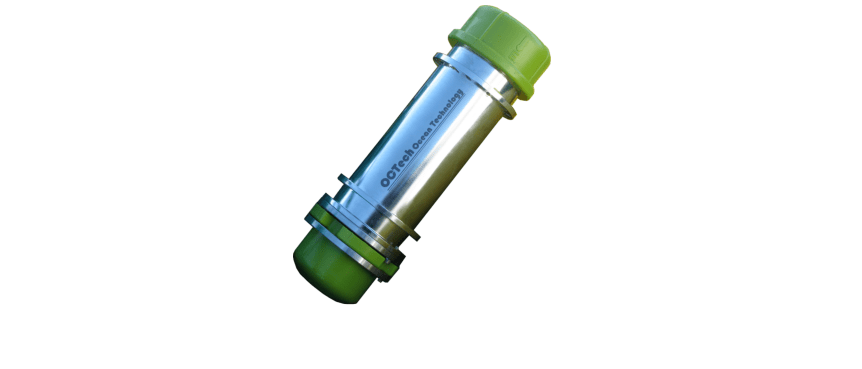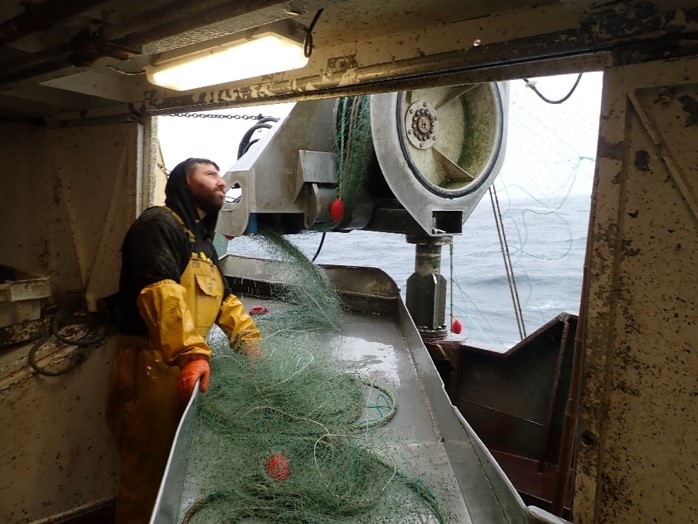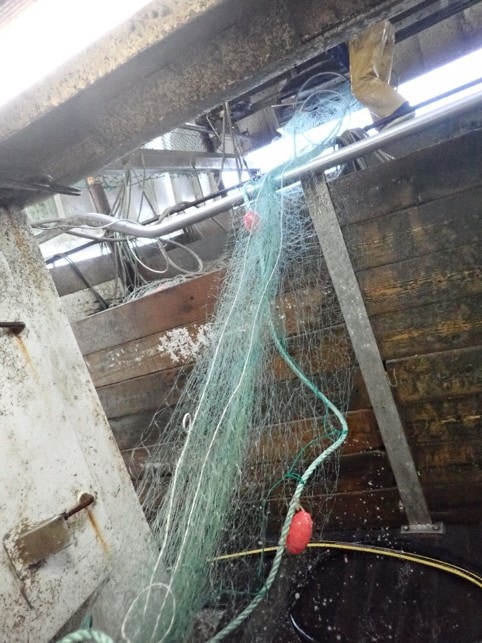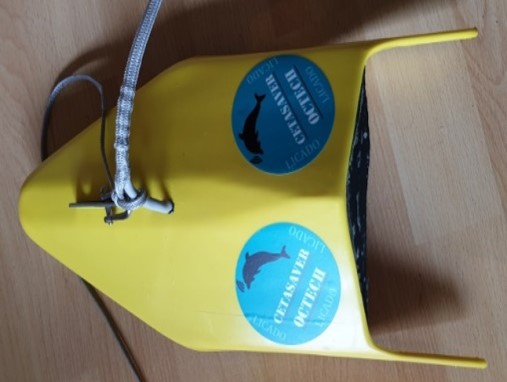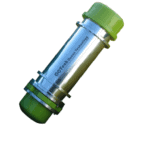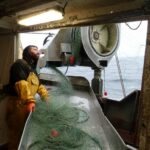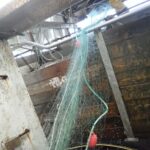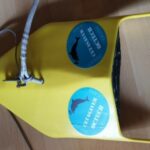Acoustic repellents « Pingers » and reflectors for netters and pelagic trawlers (LICADO project)
Sommaire
This sheet is translated in the frame of the Cetambicion project (https://www.cetambicion-project.eu/)
Contact :
• CNPMEM : cnpmem@comite-peches.fr
Source :
CNPMEM website page dedicated to the LICADO project : https://www.comite-peches.fr/LICADO-nouveau-programme-limiter-captures-accidentelles-de-dauphins/
The objectives of the LICADO project
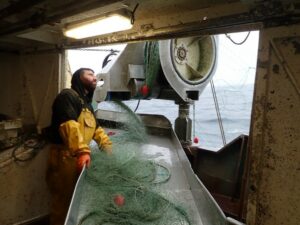
The LICADO project, supported by the CNPMEM, aims to develop pingers that can be used on both pelagic trawlers and netters. Acoustic reflectors have also been tested on nets. Starting in 2020 and lasting two years, LICADO’s objectives are to :
- For pelagic trawlers :
- Optimising the positioning of pingers on trawls,
- Evaluation of the effectiveness of CETASAVER pingers compared with pingers already in place.
- For netters :
- Development and testing of acoustic reflectors,
- The improvement of CETASAVER pingers (and the development of additional options : omnidirectional and interactive) for use on set nets (pingers fixed to the net) and during spinning.
What actions have been implemented and what are the results ?
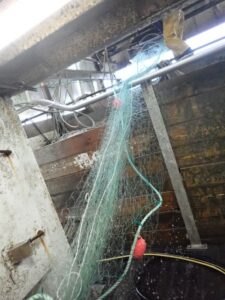
The CETASAVER emits a proven and scientifically validated acoustic repellent signal (repellent effect over a maximum of 200 metres, causing dolphins to move away in 87% of cases).
For pingers used on pelagic trawlers, it has been observed that the signals are perceived by dolphins several kilometres away.
With regard to quantifying the effectiveness of CETASAVER in reducing incidental catches compared with the current pingers (DDD), the results showed that with the sample analysed, there was no significant difference detected in the rate of bycatches per hour of trawling. However, despite the significant observation effort during these experiments (165 valid OPs), a low number of bycatches were recorded (3 catches), which reduces the chances of the statistical analysis being significant and makes this result unusable. However, this low number of bycatches is positive in that it provides a “qualitative” illustration of the reduction in bycatch levels with the use of pingers.
CETASAVER pingers have also been tested on board netters using a number of mechanisms: :
- Based on the assumption that bycatch takes place when the net is set on the seabed, a pinger has been developed that is activated only when submerged. The pinger is placed on the nets, either on the buoys or on the anchors. It listens for 30 seconds before transmitting. This ‘listening’ phase allows us to determine whether dolphins are present around the net before the acoustic emission is triggered. The pinger has a logbook that records information from the ‘listening’ function as well as the pinger’s operating data. An interactivity function has been implemented on the set pingers, which should make it possible to emit repulsive sequences only when the dolphin is in the zone. Due to the rare and random nature of bycatch by the same gillnetter, it is not possible to present quantitative results on the repulsive effect of set pingers on common dolphins. Nevertheless, these trials have enabled us to better understand the constraints linked to the installation of pingers on nets (ergonomic problems, limited battery autonomy, risk of loss, constraints linked to the handling of the devices and safety risks for crews) and to propose improvements to these prototypes before considering their deployment on a larger number of vessels.
- Based on the hypothesis that bycatch occurs at the time of spinning (as observed by professionals), a spinning pinger device was tested in the winters of 2020 and 2021. This is a hauled device equipped with a listening module and emitting the CETASAVER signal developed as part of this project. The pinger contains a “listening” function that analyses sounds underwater before it is activated in its “repulsive” function. The pinger has a ‘log’ containing information about the ‘listening’ function and recordings of the pinger’s operation. Testing of the spinning pingers in the LICADO project was completed in 2021. Full-scale tests over two winters confirmed the technical feasibility of using the device and produced encouraging initial results, although the device still needs to be upgraded to a pinger placed under the ship’s hull. The easy activation of the pinger (box on the bridge) and the autonomy of the device connected to the ship’s electricity have validated the possible use of this prototype on a larger scale, especially as this device is very popular with professionals. However, the number of fishing operations monitored makes it impossible to quantify the reduction in by-catches of common dolphins with this device. The random and rare nature of incidental catches of common dolphins by a single net fishing vessel means that trials need to be carried out on a larger number of vessels over a longer period in order to obtain statistically analysable results attesting to the performance of this system.
- The reflectors used on nets consist of a piece of mesh in the netting with acoustic properties that enable the dolphin to identify the net more easily. It has been measured that the reflective power of the net increases by 15 dB, which means that the dolphin can detect the net 5 times further away. The reflectors will be tested “in situ” and improved if necessary (problem of unravelling, potential hooks, etc.). The advantage of this device is that it does not alter the fishing practices of the sailors, as no additional handling is required either when spinning or hauling. The difficulty with this system is that it has to be made by hand, as the various reflectors have to be installed over short lengths. No solution is currently available from equipment manufacturers for fitting reflectors to longer lengths of net. Fitting by hand is time-consuming and therefore increases the cost of the net.
Following on from the LICADO project
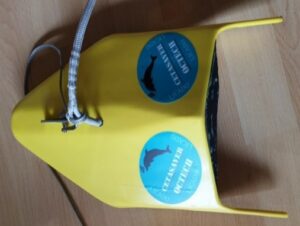
The LICADO project ended in 2022. The singular and random nature of by-catches on the scale of a netter requires a large number of fishings operations to be observed in order to be able to conclude on the effectiveness of the systems. For the whole LICADO programme, the data collected does not allow quantitative conclusions to be drawn about the effects of the devices tested. Nevertheless, the trials carried out enabled the prototypes developed to be tested and suggested ways of improving the devices before equipping a larger number of vessels.
The latest phase of tests on spinning pingers, carried out in the winter of 2021/2022, has made it possible to acquire scientific data with encouraging results. Quantifying the effectiveness of reducing bycatches on a larger scale and in a statistically significant way is one of the workstream of the PIFIL project, also supported by the CNPMEM.
Secondly,the pinger device on a set net also addresses the problem of by-catch, thanks to its tried and tested acoustic signal, while limiting noise pollution.However, it is not suitable for everyday use because of its regular recharging, its weight and the difficulty of handling it during spinning and haulning operations. Improvements to the ergonomics of the pingers are planned and could be tested, although with a different signal, as part of the DOLPHINFREE (supported by Montpellier University, MARBEC, LIRMM, Pelagis, OP Pêcheurs de Bretagne, OCTech and AGLIA) and PECHDAUPHIR project (supported by CDPMEM29) .
As for the acoustic reflectors, the few tides observed and the short length tested did not demonstrate the effectiveness of the device. A reduction in bycatches was observed, but this needs to be analysed further, as the results of the initial experiments are indicative. That said, experimentation with reflectors in the LICADO project has revealed several advantages:
- No noise pollution thanks to its passive nature,
- No ergonomic problems,
- No equipment handling requirements, resulting in an increase in crew working time,
- Reduced environmental pollution by limiting waste.
The PECHDAUPHIR project is continuing to develop and test this device.
In order to limit the by-catch of common dolphins in the Bay of Biscay, it is probably not one system but several that could be proposed, depending on the type of net, the target species, the ergonomics of the spinning operations, the type of interaction, and so on.

